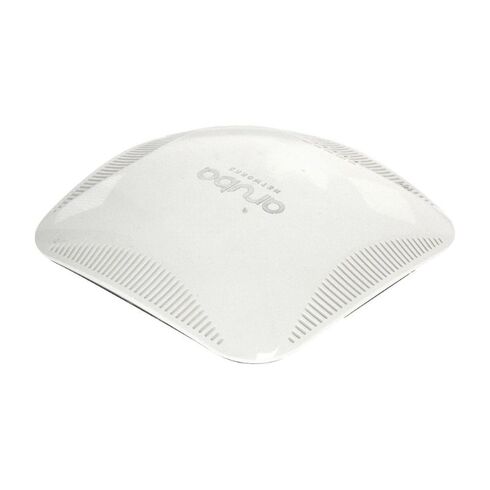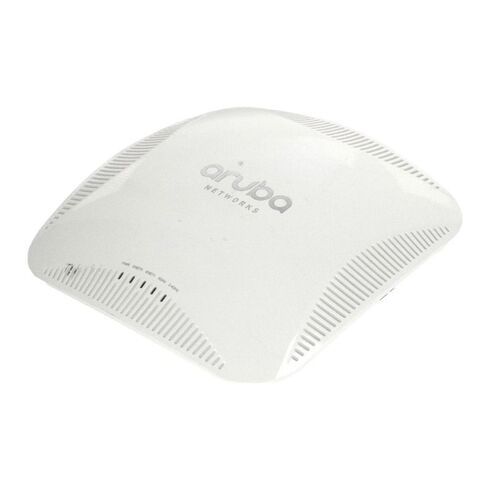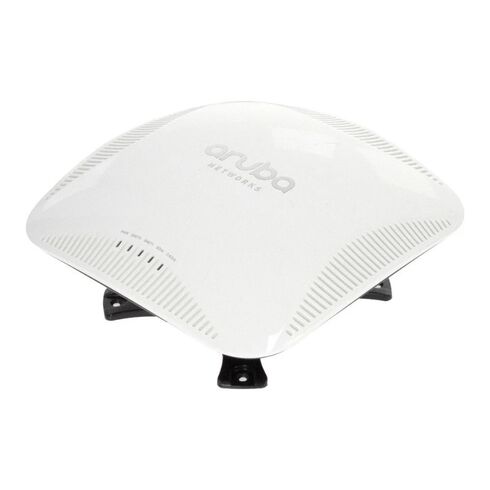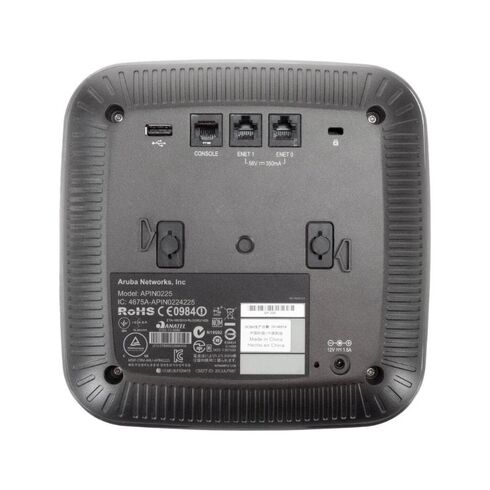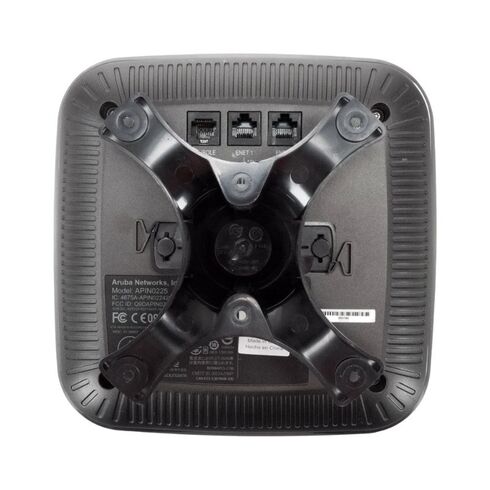JW190A HPE Aruba Instant Access Point
- — Free Ground Shipping
- — Min. 6-month Replacement Warranty
- — Genuine/Authentic Products
- — Easy Return and Exchange
- — Different Payment Methods
- — Best Price
- — We Guarantee Price Matching
- — Tax-Exempt Facilities
- — 24/7 Live Chat, Phone Support
- — Visa, MasterCard, Discover, and Amex
- — JCB, Diners Club, UnionPay
- — PayPal, ACH/Bank Transfer (11% Off)
- — Apple Pay, Amazon Pay, Google Pay
- — Buy Now, Pay Later - Affirm, Afterpay
- — GOV/EDU/Institutions PO's Accepted
- — Invoices
- — Deliver Anywhere
- — Express Delivery in the USA and Worldwide
- — Ship to -APO -FPO
- — For USA - Free Ground Shipping
- — Worldwide - from $30
Overview of HPE JW190A Aruba Instant Access Point
Key Features
- Brand: HPE
- Model Number: JW190A
- Category: Wireless Access Point (IAP)
- Type: Instant Access Point (IAP) for seamless connectivity
Comprehensive Specifications
- The HPE Aruba Instant Access Point, model JW190A, is designed to enhance network efficiency with advanced wireless technology.
Performance and Efficiency
- Optimized for high-performance environments with faster data transfer
- Provides stable connections for both small and large-scale networks
- Supports multiple devices with minimal interference
Advanced Features of Aruba Instant APs
The Aruba Instant Access Points, such as the JW190A, offer a robust set of features to address the evolving needs of modern networks.
Security Features
- Supports WPA3 encryption to safeguard data transmission
- Features built-in firewalls and intrusion prevention systems
- Easy integration with existing network security protocols
Manageability and Control
- Cloud-based management for effortless remote monitoring and configuration
- Easy-to-use interface for ongoing system monitoring
- Centralized management of multiple Aruba devices
Technical Details of the HPE JW190A
- Device Type: Wireless Access Point
- Form Factor: Compact and wall-mountable for flexible deployment
- Wi-Fi Standards: IEEE 802.11ac Wave 2, backward compatibility with earlier standards
- Ports: Multiple Ethernet ports for wired connectivity
- Power: Power over Ethernet (PoE) for efficient power management
Deployment Scenarios
- The Aruba Instant Access Point JW190A is suitable for a variety of environments, offering high-speed Wi-Fi and reliability in different use cases.
Ideal for:
- Small to medium-sized businesses
- High-density areas like offices, warehouses, and conference rooms
- Home offices requiring robust, uninterrupted internet connectivity
Wireless Standard: 802.11ac
The HPE Aruba JW190A Access Point is equipped with the latest wireless standard, 802.11ac, providing users with a high-performance and reliable wireless network connection. This feature offers numerous benefits and is of great importance for users looking to optimize their network infrastructure.
Enhanced Speed and Throughput
One of the key advantages of the 802.11ac wireless standard is its ability to deliver significantly faster data transfer speeds compared to previous standards. With a maximum data rate of 1.3 Gbps, users can experience seamless connectivity and enjoy high-bandwidth applications without any lag or interruptions. This enhanced speed and throughput are particularly beneficial for businesses that rely heavily on data-intensive tasks such as video streaming, file transfers, and cloud-based applications.
Improved Range and Coverage
802.11ac utilizes advanced beamforming technology, which enables the access point to focus its signal directly towards the connected devices. This results in improved range and coverage, allowing users to access the network from a greater distance without experiencing any signal degradation. Whether you're in a large office space or a multi-story building, the 802.11ac standard ensures that you can stay connected wherever you are.
Increased Device Capacity
In today's digital age, the number of connected devices within an organization is constantly growing. The 802.11ac standard supports higher device capacities compared to previous standards, allowing multiple devices to connect simultaneously without experiencing performance issues. This is especially important for businesses that have a high density of wireless devices, such as conference rooms or educational institutions.
Better Power Efficiency
With the 802.11ac standard, power efficiency is significantly improved compared to older standards. This is achieved through the use of advanced power-saving mechanisms such as Target Wake Time (TWT), which allows devices to schedule their wake-up times and conserve battery life. This is particularly advantageous for mobile devices such as smartphones and tablets, as it extends their battery life while ensuring a reliable wireless connection.
Frequency Band: Dual-band
The HPE Aruba JW190A Access Point operates on the dual-band frequency, which provides users with flexibility and optimal performance in their wireless network. Understanding the benefits and importance of this feature is essential for users seeking a versatile and reliable connectivity solution.
Simultaneous Connection
The dual-band frequency allows the access point to operate on both the 2.4GHz and 5GHz bands simultaneously. This means that devices can connect to either band, depending on their compatibility and network requirements. Users can take advantage of the 2.4GHz band for everyday tasks such as web browsing and email, while utilizing the less congested 5GHz band for bandwidth-intensive activities like streaming HD videos or online gaming. Simultaneous connection to both bands ensures a smooth and uninterrupted wireless experience.
Reduced Interference
The 2.4GHz band is commonly used by various devices such as microwaves, cordless phones, and Bluetooth devices, which can cause interference and impact network performance. By offering the 5GHz band, the dual-band frequency allows users to avoid these sources of interference and enjoy a more stable and reliable connection. This is especially important in environments where multiple wireless networks coexist, such as office buildings or densely populated areas.
Greater Network Capacity
The dual-band frequency offers greater network capacity by providing two distinct channels for communication. This enables users to distribute their network traffic across both bands, reducing congestion and ensuring that each device receives sufficient bandwidth for optimal performance. Whether you have a small office or a large enterprise network, the dual-band frequency allows for efficient and scalable network management.
Future-proof Solution
As technology continues to evolve, the dual-band frequency ensures that your wireless network is ready for future advancements. With more devices supporting the 5GHz band and new applications requiring higher bandwidth, the dual-band frequency provides the necessary infrastructure to accommodate these changes. By investing in a dual-band access point, users can future-proof their network and avoid costly upgrades in the long run.
Maximum Data Transfer Rate: 1.3 Gbps
The HPE Aruba JW190A Access Point offers a maximum data transfer rate of 1.3 Gbps, making it ideal for users who require fast and reliable wireless connectivity. Understanding the benefits and importance of this feature is crucial for businesses and individuals who rely on high-speed data transmission.
Seamless Multimedia Streaming
With a maximum data transfer rate of 1.3 Gbps, users can enjoy seamless multimedia streaming without any buffering or lag. Whether you're streaming HD videos, hosting video conferences, or conducting online training sessions, this high data transfer rate ensures a smooth and uninterrupted experience. This is particularly important in environments where multiple devices are accessing bandwidth-intensive applications simultaneously.
Rapid File Transfers
In today's fast-paced business environment, time is of the essence. The 1.3 Gbps data transfer rate allows for rapid file transfers, enabling businesses to share large files quickly and efficiently. This is particularly beneficial for industries such as graphic design, architecture, and video production where large file sizes are common. With faster file transfers, productivity is enhanced, and valuable time is saved.
Efficient Cloud Connectivity
As more businesses migrate their operations to the cloud, a high data transfer rate becomes crucial for efficient cloud connectivity. The 1.3 Gbps transfer rate ensures that users can seamlessly access and upload data to cloud-based applications and services. This is especially important for businesses that rely on real-time collaboration and data synchronization across multiple locations.
Optimized User Experience
The high data transfer rate of 1.3 Gbps guarantees an optimized user experience for all connected devices. Whether you're browsing the web, downloading files, or using cloud-based applications, the fast transfer rate ensures that tasks are completed quickly and efficiently. This not only improves productivity but also enhances user satisfaction.
Number Of Ethernet Ports: 1
The HPE Aruba JW190A Access Point comes with one Ethernet port, offering users a reliable wired connection option alongside its wireless capabilities. Understanding the benefits and importance of this feature is essential for users who require a versatile network setup.
Wired Connectivity Options
While wireless connectivity is convenient and flexible, there are instances where a wired connection is preferred or necessary. The presence of an Ethernet port allows users to connect devices directly to the access point via an Ethernet cable. This is particularly useful for devices that do not have built-in Wi-Fi capabilities or for ensuring a stable and uninterrupted connection in areas with poor wireless coverage.
Seamless Integration with Existing Infrastructure
The single Ethernet port enables seamless integration with existing network infrastructure. Users can connect the access point to their existing network switch or router without the need for additional hardware or complex configurations. This makes it easy to incorporate the access point into an existing network setup, allowing for a smooth transition to a hybrid wired and wireless environment.
Optimal Placement and Coverage
With a single Ethernet port, users have the flexibility to position the access point in the most optimal location for maximum coverage. This is particularly important in scenarios where multiple access points are deployed, as it allows for strategic placement to ensure uniform coverage throughout the desired area. By leveraging both wired and wireless connectivity, users can create a comprehensive network infrastructure that meets their specific coverage requirements.
Flexible Network Expansion
The presence of an Ethernet port provides users with the ability to expand their network infrastructure easily. As businesses grow or as new areas need to be covered, additional access points can be connected to the existing network via Ethernet cables. This scalability ensures that the network can adapt to changing needs without compromising performance or security.
Power Over Ethernet: 1
The HPE Aruba JW190A Access Point supports Power over Ethernet (PoE), allowing for both data and power transmission over a single Ethernet cable. Understanding the benefits and importance of this feature is crucial for users seeking a convenient and efficient power solution for their access point.
Simplified Installation
By supporting Power over Ethernet, the access point can be easily installed in locations where power outlets are scarce or not easily accessible. With PoE, there is no need for additional power adapters or electrical wiring, as both power and data are delivered through a single Ethernet cable. This simplifies installation and eliminates the need for extensive cabling, reducing costs and time required for setup.
Flexible Placement Options
With PoE, users have greater flexibility in determining the optimal placement of their access points. Since power is delivered through the Ethernet cable, access points can be installed in locations where power outlets are not available, such as ceilings or walls. This allows for strategic placement to ensure optimal coverage and performance, without being restricted by power source limitations.
Centralized Power Management
Power over Ethernet enables centralized power management, providing users with control and monitoring capabilities over their network devices. The access point can be powered on or off remotely, allowing for efficient power management and conservation. Additionally, PoE switches often provide advanced power management features, such as power scheduling and consumption monitoring, which further optimize energy usage.
Reliable Power Delivery
By utilizing PoE, the access point receives power from a centralized source, such as a PoE switch or injector. This ensures a reliable and consistent power supply, reducing the risk of power interruptions that could affect network performance. With a stable power connection, users can rely on their access point to deliver uninterrupted wireless connectivity to their devices.
Antenna Type: Internal
The HPE Aruba JW190A Access Point is equipped with internal antennas, providing users with a compact and sleek design while delivering high-performance wireless coverage. Understanding the benefits and importance of this feature is key for users seeking a discreet yet powerful access point solution.
Simplified Aesthetics
Internal antennas offer a sleek and streamlined design that seamlessly blends into any environment. The absence of external antennas eliminates the need for additional mounting or adjustment, resulting in a clean and clutter-free appearance. This is particularly advantageous in environments where aesthetics are important, such as hotels, restaurants, or modern office spaces.
Enhanced Mobility
The internal antennas ensure that the access point remains compact and lightweight, making it highly portable and easy to deploy in various locations. Whether you need to move the access point between different rooms or deploy it in temporary setups, the internal antennas allow for enhanced mobility and flexibility. This is ideal for businesses that require quick and easy network deployments or for organizations that frequently rearrange their workspace.
Optimal Signal Distribution
Internal antennas are strategically designed to provide optimal signal distribution, ensuring uniform coverage throughout the desired area. The placement and orientation of internal antennas are carefully engineered to minimize signal interference and maximize signal strength. This results in reliable and consistent wireless connectivity for all connected devices, regardless of their location within the coverage area.
Protection Against Damage
With internal antennas, there is no risk of external antennas being accidentally damaged or misaligned. This provides users with peace of mind, knowing that their access point's antennas are protected and less prone to physical damage. Additionally, the internal antennas are less susceptible to environmental factors such as wind or extreme weather conditions, ensuring reliable performance in various environments.
Security Features: WPA2, AES encryption
The HPE Aruba JW190A Access Point incorporates robust security features, including WPA2 and AES encryption, to ensure the confidentiality, integrity, and authenticity of wireless communications. Understanding the benefits and importance of these features is crucial for users seeking a secure and protected network environment.
Secure Data Transmission
WPA2 (Wi-Fi Protected Access 2) is the most current and secure wireless encryption standard available. By implementing WPA2, the access point ensures that all data transmitted over the wireless network is encrypted and protected from unauthorized access. This provides users with peace of mind, knowing that their sensitive information is secure and cannot be intercepted or tampered with.
Robust Authentication Mechanisms
WPA2 employs strong authentication mechanisms to verify the identity of devices attempting to connect to the network. This prevents unauthorized devices from gaining access and ensures that only trusted devices can connect. By implementing robust authentication mechanisms, the access point protects against unauthorized access attempts, reducing the risk of data breaches or network intrusions.
Advanced Encryption Standard (AES)
The use of AES encryption further enhances the security of wireless communications. AES is a symmetric encryption algorithm widely recognized for its strength and efficiency. By encrypting data using AES, the access point ensures that even if an unauthorized party intercepts the wireless traffic, they will be unable to decipher or decrypt the encrypted data. This provides an additional layer of protection against data theft or unauthorized access to sensitive information.
Compliance with Industry Standards
By incorporating WPA2 and AES encryption, the access point complies with industry standards and best practices for wireless security. This ensures interoperability with other devices and networks that adhere to the same security standards. Compliance with industry standards is essential for businesses that handle sensitive customer data or are subject to regulatory requirements, such as healthcare organizations or financial institutions.
Management Interfaces: Web GUI, CLI, Aruba Central
The HPE Aruba JW190A Access Point offers multiple management interfaces, including a web GUI, CLI, and integration with Aruba Central. Understanding the benefits and importance of these interfaces is crucial for users seeking efficient network management and monitoring capabilities.
User-Friendly Web GUI
The web graphical user interface (GUI) provides users with an intuitive and user-friendly interface for managing and configuring the access point. Through a web browser, users can access the GUI and easily navigate through various settings and options. The GUI eliminates the need for complex command-line configurations and allows users to perform actions such as network setup, firmware updates, and monitoring without extensive technical knowledge.
Powerful Command-Line Interface (CLI)
The command-line interface (CLI) offers advanced users and network administrators a powerful and efficient way to manage the access point. With the CLI, users can access a command prompt and enter commands to configure, monitor, and troubleshoot the device. The CLI provides more granular control over the access point's settings and allows for automation and scripting of management tasks. This is particularly beneficial for larger networks where bulk configurations or advanced troubleshooting is required.
Integration with Aruba Central
Aruba Central is a cloud-based network management platform that enables centralized monitoring, configuration, and troubleshooting of Aruba devices. By integrating the access point with Aruba Central, users gain a single pane of glass view into their entire network infrastructure. This allows for simplified management, real-time monitoring, and proactive troubleshooting from anywhere with an internet connection. Aruba Central is especially valuable for businesses with multiple locations or distributed networks.
Simplified Network Provisioning
The combination of web GUI, CLI, and Aruba Central provides users with simplified network provisioning capabilities. Whether you prefer a graphical interface for initial setup or require advanced automation through the CLI, these management interfaces ensure that network configuration and provisioning processes are streamlined and efficient. This saves time and effort during initial deployment as well as ongoing maintenance tasks.
Mounting Options: Ceiling mount, Wall mount
The HPE Aruba JW190A Access Point offers versatile mounting options, including ceiling mount and wall mount capabilities. Understanding the benefits and importance of these options is crucial for users seeking flexibility in deploying their access points.
Ceiling Mount
The ceiling mount option allows users to discreetly install the access point on the ceiling, providing optimal coverage with minimal visual impact. This is particularly useful in environments where aesthetics are important, such as hotels, retail stores, or modern office spaces. By mounting the access point on the ceiling, users can ensure uniform coverage throughout the desired area while maintaining a

